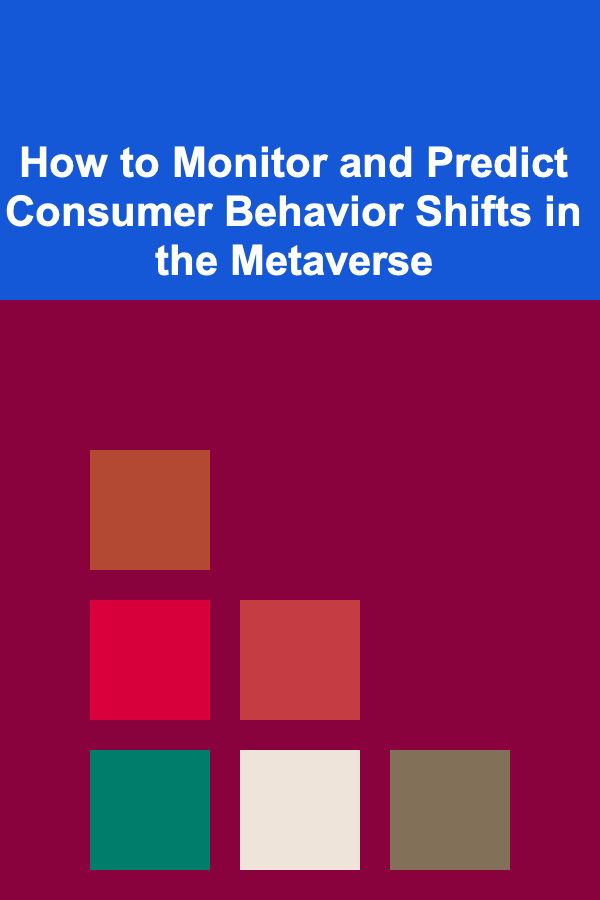
How to Monitor and Predict Consumer Behavior Shifts in the Metaverse
ebook include PDF & Audio bundle (Micro Guide)
$12.99$11.99
Limited Time Offer! Order within the next:

The Metaverse is a rapidly evolving digital ecosystem that has begun to capture the attention of businesses, technologists, and consumers alike. As virtual worlds, augmented reality, and interconnected digital spaces become more integrated into daily life, the Metaverse presents unique opportunities for companies to engage with consumers in ways that were once unimaginable. Understanding how to monitor and predict shifts in consumer behavior within the Metaverse is crucial for businesses hoping to stay competitive in an increasingly digital economy.
In this article, we will delve into various strategies, tools, and methodologies for monitoring and predicting consumer behavior shifts in the Metaverse. By examining the key trends, technological advancements, and data analytics techniques available, companies can gain deeper insights into how users interact with virtual environments, and how these behaviors can inform future business decisions.
Understanding the Metaverse: The Foundation for Consumer Behavior Analysis
Before diving into monitoring and predicting shifts in consumer behavior, it's important to first understand the Metaverse itself. The Metaverse is a collective virtual shared space created by the convergence of virtually enhanced physical reality, augmented reality (AR), virtual reality (VR), and the internet. It is often seen as a next step in the evolution of the internet---moving from static websites and social media platforms to immersive, interactive digital environments.
The Metaverse is not confined to a single platform or ecosystem. Instead, it encompasses various interconnected virtual spaces where users can socialize, interact with digital assets, play games, attend events, and purchase virtual goods. This multiplicity of experiences presents both challenges and opportunities for businesses, as they seek to track and predict consumer behavior across a fragmented virtual landscape.
Key Drivers of Consumer Behavior in the Metaverse
Several factors influence consumer behavior in the Metaverse, and understanding these drivers is essential for predicting future trends. Some of the key drivers include:
2.1 Immersive Experiences
Unlike traditional online shopping or browsing, the Metaverse offers an immersive, 3D experience that allows users to interact with digital objects, avatars, and environments. This immersion creates a deeper sense of presence and engagement, which can significantly influence consumer decision-making.
For example, users can visit virtual stores, try on digital products, or participate in brand activations within the Metaverse. These interactions can lead to a stronger emotional connection with brands and products, increasing the likelihood of purchases or brand loyalty.
2.2 Virtual Goods and NFTs
Virtual goods and non-fungible tokens (NFTs) are becoming increasingly popular in the Metaverse. Consumers are buying digital fashion, art, collectibles, and even land in virtual worlds. The value of these goods is often driven by their rarity, uniqueness, and the status they confer within the virtual space.
The rise of NFTs in the Metaverse has created new opportunities for brands to monetize digital products, while also offering new ways for consumers to express their identity and social status. This trend is particularly significant in the gaming and fashion industries, where virtual items can hold significant cultural value.
2.3 Social Interaction and Community Building
One of the core features of the Metaverse is its emphasis on social interaction. Users can connect with others, form communities, and participate in collaborative activities. These social dynamics are a key factor in shaping consumer behavior, as users are often influenced by their peers and social networks.
For example, virtual events, such as concerts or product launches, can attract large crowds of users who participate not only as consumers but also as active participants in the brand experience. Social proof, peer influence, and community-building mechanisms all play a significant role in driving consumer decisions in the Metaverse.
2.4 Gamification and Rewards
Gamification is a significant driver of consumer behavior in the Metaverse. Virtual worlds often incorporate game-like elements, such as points, levels, and rewards, to incentivize engagement and participation. These mechanics can encourage users to spend more time in virtual environments and take actions that align with business objectives.
For instance, users may earn rewards by completing challenges or participating in branded experiences. These rewards could range from virtual currency to exclusive virtual items, which further strengthen the consumer's connection to the brand and the virtual space.
Methods for Monitoring Consumer Behavior in the Metaverse
Monitoring consumer behavior in the Metaverse requires the use of specialized tools and methodologies that go beyond traditional web analytics. Here are some of the most effective approaches:
3.1 Tracking User Interactions and Engagement Metrics
In virtual environments, every user interaction can be tracked, from the amount of time spent in a particular virtual space to the frequency of interactions with virtual objects and brands. These data points provide valuable insights into consumer preferences and behaviors.
Key engagement metrics to monitor include:
- Time spent in virtual environments: Longer engagement times can indicate a strong emotional connection or interest in the brand or product.
- Interaction rates: Tracking how often users interact with virtual products, items, or brands can offer insights into product interest and popularity.
- User-generated content: Monitoring the content users create, such as custom avatars or virtual products, can provide clues about brand preferences and user creativity.
3.2 Analyzing Social Media and Community Discussions
The Metaverse extends beyond the virtual world itself and into social media platforms, forums, and online communities. Analyzing user-generated content, discussions, and sentiment on these platforms can provide valuable feedback on how consumers perceive brands and experiences within virtual spaces.
By using sentiment analysis tools and natural language processing (NLP) techniques, businesses can gain insights into consumer feelings and opinions about their products, services, or virtual activations. Social listening can help brands stay informed about emerging trends, user concerns, and potential opportunities for improvement.
3.3 Utilizing Virtual Marketplaces and Transactions Data
Virtual marketplaces, where users buy and sell digital goods, provide another valuable source of data. By monitoring transaction volumes, purchase patterns, and the popularity of certain items, businesses can identify trends in consumer demand and make data-driven decisions about product offerings.
For example, if a particular style of virtual clothing is selling well in a virtual marketplace, a fashion brand may choose to create similar items or host a digital fashion show to capitalize on the trend. Similarly, virtual real estate transactions can provide insights into the growing demand for certain virtual spaces.
3.4 Conducting Virtual Surveys and Polls
Surveys and polls are a direct method of gathering consumer feedback in the Metaverse. By integrating these tools into virtual environments or platforms, businesses can obtain real-time insights into user preferences, attitudes, and experiences.
For example, virtual surveys can be conducted after a branded event, where users are asked about their overall experience and interest in the product or service. This direct feedback is invaluable for refining future marketing efforts and ensuring that consumer needs are met.
Predicting Shifts in Consumer Behavior in the Metaverse
Predicting consumer behavior shifts in the Metaverse is a complex task that requires both advanced data analytics and an understanding of the cultural and technological forces shaping virtual spaces. Here are some strategies to forecast future trends:
4.1 Analyzing Behavioral Patterns and Predictive Analytics
By collecting and analyzing data on user behavior, businesses can identify patterns that may indicate upcoming trends. Predictive analytics tools can then be used to model these patterns and forecast future shifts in consumer behavior. This can help businesses anticipate demand for certain virtual goods, experiences, or services.
For example, if an increasing number of users are customizing their avatars with specific fashion items, a brand might predict a shift in demand for similar virtual clothing or accessories.
4.2 Leveraging Artificial Intelligence and Machine Learning
Artificial intelligence (AI) and machine learning (ML) are powerful tools for predicting consumer behavior in the Metaverse. By training algorithms on historical data, businesses can identify correlations and predict future trends with a high degree of accuracy.
For example, AI-powered recommendation engines can suggest virtual items or experiences to users based on their past behavior and preferences. Similarly, machine learning models can analyze user interactions across different virtual environments to identify emerging trends or shifts in consumer preferences.
4.3 Observing the Evolution of Virtual Communities
As virtual communities evolve, so too do the behaviors of their members. Monitoring the dynamics of these communities---such as the emergence of new social groups, shifts in communication styles, or the popularity of certain topics---can provide valuable insights into how consumer behavior is changing.
For instance, if a new virtual space dedicated to fitness or wellness gains popularity, businesses in related industries (such as health, wellness, or sports brands) may want to explore opportunities to engage with these communities.
4.4 Monitoring Technological Advancements
The Metaverse is constantly evolving, and new technological advancements can have a profound impact on consumer behavior. For example, the introduction of new AR/VR technologies, improvements in haptic feedback, or the integration of AI-powered avatars could influence how users engage with virtual environments and brands.
By staying informed about the latest technological developments, businesses can anticipate how these innovations might shape consumer expectations and behaviors in the future.
Conclusion: Adapting to the Metaverse's Shifting Landscape
The Metaverse presents unique challenges and opportunities for businesses seeking to monitor and predict consumer behavior. By leveraging advanced data analytics, tracking user engagement, and staying informed about technological advancements, businesses can gain a deeper understanding of the Metaverse's evolving landscape and make informed decisions about how to engage with consumers in this new digital frontier.
As the Metaverse continues to grow and evolve, businesses must remain agile and adaptable, continuously refining their strategies to meet the changing needs and expectations of consumers. By doing so, they can ensure that they remain competitive in this exciting new space.
Reading More From Our Other Websites
- [Organization Tip 101] How to Create a Digital Catalog of Vintage Items
- [Home Maintenance 101] How to Minimize Maintenance Costs of Your House Over Time
- [Home Renovating 101] How to Plan for Outdoor Living Spaces in Renovation
- [Home Staging 101] How to Create a Cozy Feel with Staging: What Techniques Make a Home Feel Warm and Welcoming?
- [Skydiving Tip 101] Beyond the Freefall: Unforgettable Skydiving Locations Around the World
- [Organization Tip 101] How to Manage Passwords Safely with a Password Manager
- [Personal Care Tips 101] How to Match Your Perfume with Your Fashion Style
- [Home Rental Property 101] How to Handle Security Deposits Correctly: A State-Specific Guide for the USA
- [Survival Kit 101] Best Survival Kit for Boaters and Kayakers Navigating Unpredictable Rivers
- [Organization Tip 101] How to Store Baking Supplies Neatly for Easy Access

Common Mistakes to Avoid When Saving for Retirement
Read More
How to Build a Checklist for Using Social Media Analytics to Track Performance
Read More
How to Create the Illusion of More Space in Your Home
Read More
How to Highlight Your Home's Outdoor Living Space for Buyers
Read More
How to Update Your Home's Windows for Better Efficiency
Read More
How To Identify Chekhov's Gun in Movies
Read MoreOther Products

Common Mistakes to Avoid When Saving for Retirement
Read More
How to Build a Checklist for Using Social Media Analytics to Track Performance
Read More
How to Create the Illusion of More Space in Your Home
Read More
How to Highlight Your Home's Outdoor Living Space for Buyers
Read More
How to Update Your Home's Windows for Better Efficiency
Read More